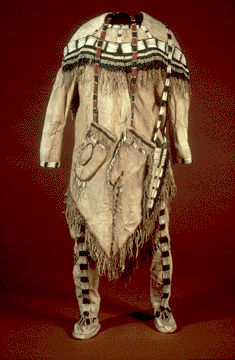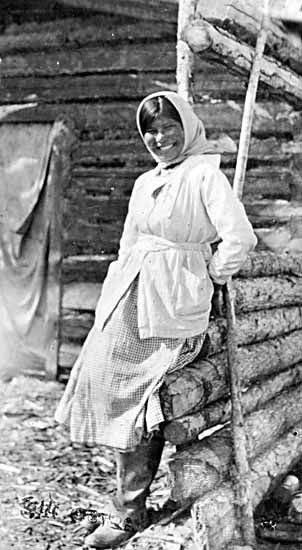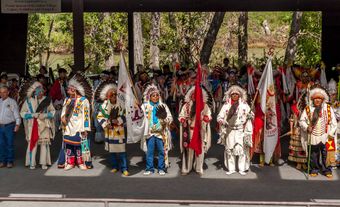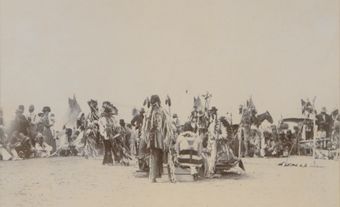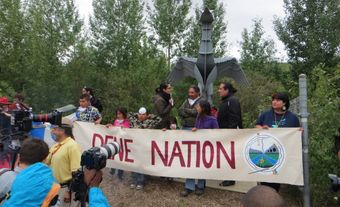Dinjii Zhuh (also Gwich’in, formerly Kutchin), meaning “one who dwells (in)” or “the inhabitant of,” are Dene (Athabaskan)-speaking Indigenous peoples who live in northwestern North America. These communities are often referred to collectively as Dinjii
Zhuh, although some First Nations and the Gwich’in Tribal Council retain the Gwich’in name. There are thought to be between 7,000 and 9,000 Dinjii Zhuh living in communities in Alaska, Yukon and the Northwest Territories.
Territory and Population
The Dinjii Zhuh are among the northernmost of all Indigenous peoples in North America. They occupied a broad sweep of territory located primarily north of the Arctic Circle, which extends across the Mackenzie drainage and the northern tributaries of the Yukon River and into north-central Alaska. Their northern boundary touches Inuit land that stretches from the Brooks Range mountains and the Coleville region in Alaska to the Mackenzie Bay region in Yukon. The following describes some Dinjii Zhuh communities in the Yukon, Northwest Territories and Alaska:
Old Crow, Yukon Territory
(courtesy Native Land Digital / Native-Land.ca)
Vuntut Gwitchin, meaning “people of the lakes,” refers to the people who live in the settlement of Old Crow, Yukon (i.e. the Crow Flats area). Located 128 km north of the Arctic Circle at the confluence of the Porcupine and Crow rivers, Old Crow is the northernmost Yukon community. In the 2016 census, 220 people reported having Indigenous identity in Old Crow, though this figure does not reflect the number of registered Dinjii Zhuh or other Indigenous peoples.
Northwest Territories
Dinjii Zhuh communities in northeastern Alaska include Arctic Village, Dendu Gwich’in (Birch Creek), Draan’jik Gwich’in (Chalkyitsik), Danzhit Hanlaih Gwich’in (Circle), Gwich’yaa Gwich’in (Fort Yukon) and Neets’ąįį Gwich’in (Venetie). About 1,500 Dinjii Zhuh are thought to live in Alaska.
Traditional Life
Regional bands traditionally depended on moose and caribou hunting in upland areas, and salmon fishing in lowland areas. Even though big game supplied the greater part of their food and hides for clothing and shelter, the Dinjii Zhuh also caught whitefish, hare and other small game. They ate plant foods such as berries and rhubarb to supplement their diet.
Dinjii Zhuh technology was similar to that of other subarctic Dene peoples (see also Subarctic Indigenous Peoples in Canada), with distinctive western elements (after the period of contact), including large metal knives, sleds, chair-style birchbark baby carriers, Inuit-designed birchbark canoes with fairly straight sides and flat bottoms, and portable domed caribou-skin tents.
Adults and children alike wore V-tailed summer shirts decorated with red ochre, dentalium (beads made with mollusc shells) and dyed porcupine quills. Women tattooed their chins and, on ceremonial occasions, men coiffed their hair with red ochre mixed with grease and sprinkled it with down.
Social Organization
Traditionally, a typical household was formed by the respective nuclear families of two brothers or sisters. Several households associated with the same senior person or chief made up a local band, and worked together to build caribou surrounds (enclosures used to snare caribou) and large fish traps. Sometimes larger groups met to hunt. Several local bands formed a regional band, which was maintained through intermarriage and other interactions between families. Regional bands assembled for annual festivities and ceremonies such as marriages, funerals and feasts that marked the birth of a first child, a son’s first kill of big game, or the end of a daughter’s puberty isolation.
Three matrilineal clans cross-cut the band structure and regulated marriage: Nantsaii, Chits’yaa and Tenjeraatsaii (Teenjaaraatsyaa). Though not much is known about these historical clans, it is said that Nantsaii and Chits’yaa (Chi’ichyaa) were considered primary clans, whereas Tenjeraatsaii was reserved for children, people outside of the clan system and people who married within their own clan (which was considered taboo).
Today, Dinjii Zhuh bands in Canada are regulated under the Indian Act. Organizations such as the Gwich’in Tribal Council and Gwich’in Council International serve communities in Canada and the US and represent their issues and interests to their respective governments.
Culture
Dinjii Zhuh culture is deeply connected to the land and its resources. Hunting, trapping and fishing remain significant elements of Dinjii Zhuh economy and way of life. Institutions such as the Gwich’in Social and Cultural Institute seek to preserve and promote the traditional knowledge and language of the Dinjii Zhuh.
Music, dance and certain Dene customs also permeate Dinjii Zhuh culture. The Dinjii Zhuh have adopted and adapted fiddle music and jigs. The Duck Dance and the Rabbit Dance are just two of many traditional dances. As in many Indigenous communities, drumming is culturally significant and can be heard at different gatherings and ceremonies. The Dinjii Zhuh also share certain cultural practices and customs with other Dene peoples, such as the Slavey. The Dinjii Zhuh participate in Dene games such as Stick Pull and Hand Games. (See also Arctic Winter Games).
The residential school system tore Dinjii Zhuh children and families apart from their culture. While the legacy of residential schools still lingers, Dinjii Zhuh culture has survived. Various educational institutions now actively seek to reclaim their culture, history and heritage.
Religion and Spirituality
The Dinjii Zhuh world view includes beliefs in spirit beings, animal spirits, people with supernatural attributes and the cultural hero-trickster Raven (crow). Known as Dotson’Sa in the Dinjii Zhuh language, Raven is revered as a benevolent figure who helps the Dinjii Zhuh to navigate the world but also enjoys playing tricks on people, sometimes ending in their getting into trouble. (See also Raven Symbolism and Religion and Spirituality of Indigenous Peoples in Canada.)
Origin Stories
Story telling is an important part of Dinjii Zhuh culture. People often gathered to hear stories from elders and others who spoke of the past and of Dinjii Zhuh legends. Stories told about the origins of humanity, nature and animal life. They also taught lessons and transmitted Dinjii Zhuh spiritual beliefs.
There are variations of the Dinjii Zhuh creation story. However, most generally state that Man and Caribou were created with a piece of the other’s heart in his own. In this way, they are spiritually, physically and mentally connected. They know each other’s habits, respect one another and help each other to survive (i.e. the Caribou provides food for Man, and Man only takes what he needs and protects the environment of the Caribou).
Language
The Dinjii Zhuh speak a Dene language that is also known as Dinjii Zhuh Ginjik, Gwich'in, Loucheux, Kutchin or Tukudh. At the time of contact, there were nine distinct Dinjii Zhuh groups, each of which spoke its own dialect. Changes in population due to epidemics and other factors resulting from contact with Europeans resulted in the amalgamation of some groups and their dialects. Today, there are two main Dinjii Zhuh languages (although there are various dialects within each): one that is spoken in Alaska and the other that is spoken in the Yukon and the Northwest Territories. Dinjii Zhuh Ginjik is one of the official languages of the Northwest Territories.
Archdeacon Robert McDonald (1829-1913), a Protestant missionary who worked amongst the Dinjii Zhuh in the 1860s, developed the first writing system for the Dinjii Zhuh language. In collaboration with the Dinjii Zhuh, McDonald translated the Bible and other prayer and hymnal books that some still use today. However, the language has evolved since the 1860s, and is now characterised by a modern writing system. Developed by linguist Richard Mueller, and adapted by the Yukon Native Language Centre in the 1970s, the new system reflects sounds in the Dinjii Zhuh language more consistently and accurately than the older version. Dinjii Zhuh youth are more familiar with the modern style of spelling and orthography.
Although figures differ depending on the source, the 2016 census reported that out of the Indigenous population, 270 people reported Dinjii Zhuh Ginjik (Gwich’in) as their mother tongue. Considered endangered, organizations such as the Gwich’in Social and Cultural Institute and the Gwich’in Language Centre work with language experts and fluent speakers to maintain and strengthen the language.
Colonial History
In 1789, the Dinjii Zhuh made contact with Alexander Mackenzie south of the Mackenzie Delta. Within two decades, they were trading at posts on the Mackenzie River. This trade network prompted the Hudson’s Bay Company to establish Fort McPherson on the Peel River in 1840 and Fort Yukon (Alaska) in 1847. Having served as intermediaries in trade between the coastal Inuit and interior Indigenous communities, and between the Mackenzie and Yukon communities, the Dinjii Zhuh resented the existence of European trading posts in their territory. During the middle of the 19th and into the early 20th century, epidemics such as influenza significantly reduced Dinjii Zhuh populations. Old Crow progressively became the focal point and then the only Dinjii Zhuh town in the Yukon.
Treaty 11
In 1921, the Dinjii Zhuh and some other Indigenous nations signed Treaty 11 with the Canadian government, providing the federal government with land for development in exchange for certain rights to the land. The last of the Numbered Treaties, Treaty 11 covers more than 950,000 km2 of present-day Yukon, Northwest Territories and Nunavut. Hasty negotiations on the part of the government, combined with weak implementation of the terms of the treaty — particularly with regard to reserves and land claims — have led to considerable disagreement between the parties on what was meant by the treaty and which promises have not been fulfilled. As a result, many of the signatories to Treaty 11 have also been involved in the modern treaties process. (See also Treaties with Indigenous Peoples in Canada.)
Gwich’in Comprehensive Land Claim Agreement
Contemporary Life
The current Dinjii Zhuh population is thought to be between 7,000 and 9,000 persons, with slightly more than half living in Old Crow, Tetlit Zhee (Fort McPherson, where the greatest number of Dinjii Zhuh of any single settlement live) and Tsiigehtchic, or in the relatively large mixed Inuit/First Nations/non-Indigenous communities of Aklavik and Inuvik. The remainder (approximately 1,500 people) live in Alaska. Although communities have regular air services, only a few can be reached by road, such as Tetlit Zhee and Tsiigehtchic.
Well-known personages among the Dinjii Zhuh include Edith Josie (Old Crow), journalist and recipient of the Order of Canada; Charlie Peter Charlie (Old Crow), chief and band councillor; and John Tetlichi, the first Indigenous member of the Northwest Territories Territorial Council. (See also Territorial Government in Canada.)

 Share on Facebook
Share on Facebook Share on X
Share on X Share by Email
Share by Email Share on Google Classroom
Share on Google Classroom
